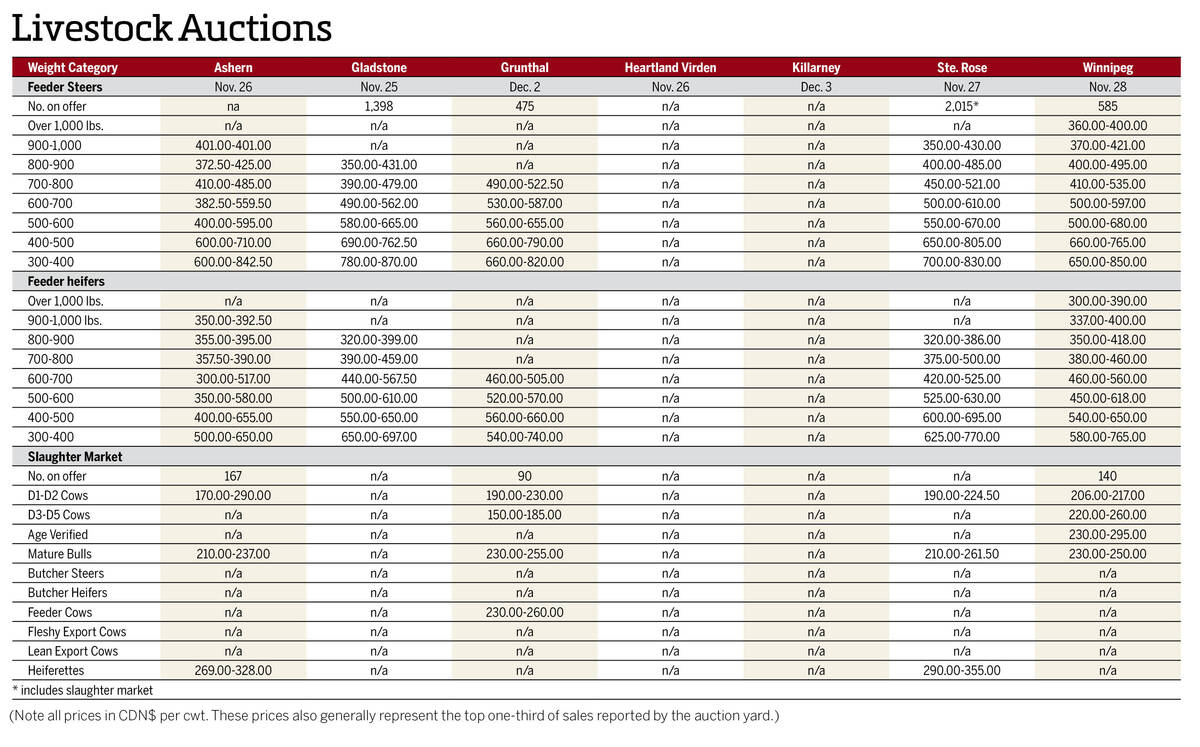Many producers use remote drug delivery devices. If you are thinking of using one, or if you have used one in the past, this article may be a good review.
Dart guns have their pros and cons but the Beef Cattle Research Council has some great resources that can help. It offers guidelines on usage decisions, staying within beef quality guidelines, safety and avoiding drug residue issues.
Producers and veterinarians advocate the need when animals can’t be caught or timing is critical for a favourable outcome. There are also times where a severely fractious animal makes it unsafe for the handler. Roping or other restraint may be impossible.
Read Also

Manitoba cattle prices, Dec. 3
Cattle prices from Manitoba’s major livestock auction marts during the week Nov. 25-Dec. 2, 2025.
Dart guns are here to stay, and as with regular vaccination methods, users must consider drug residues, food safety, animal welfare and accuracy of administration.
The level of use is already high but it’s good to have an easily accessible reference source to help decide whether to use a dart gun.
Some may still have a workable crossbow or pole syringe, but the dart gun definitely meets more of the criteria of beef quality assurance. It administers a more accurate volume in the best manner – subcutaneously. It is accurate and doesn’t cause too much damage to surrounding tissues.
It’s also critical to know when not to use a dart gun. Because they are so easy to use, they might be over-used or used simply for convenience and before a proper diagnosis.
A decision tree developed by BCRC helps determine whether to treat the animal and if so, when to use a remote delivery device. One must stick closely to beef quality guidelines so the decision tree really helps.
Before darting, one must have a diagnosis, then a treatment plan and then record the animal in case slaughter withdrawals come into play.
Pneumonia, foot rot and occasionally pinkeye are common maladies treated by producers. Veterinarians generally go by the adage that everything given by a dart gun must conform to the label, so it is critical to have a veterinary-client-patient relationship. The goal is to give the product the same way as we would in a squeeze chute or if the animal was caught.
There is a do and don’t list and a pamphlet available, and the BCRC website has both the decision tree and a review of drug delivery.
There are a few absolute no-no’s. For example, do not use tilmicosin (Micotil) because of human safety concerns and know that a product like Excede must be given behind the ear.
The pharmacology industry is very much behind decisions of never using these specific products in dart guns.
BCRC’s list is easy to follow and captures most points when it comes to darting. It should be done as a last resort and use should be avoided on calves under 200 pounds because they don’t have much neck area to work with. Such calves can often be caught by other means.
Try to retrieve as many darts as possible. Don’t use them in the feedlot unless a severely stressed and fractious animal is compromising his and your safety.
The simplest way to find the BCRC resource is to visit its website (https://tinyurl.com/5xhj5wsv). There you’ll find a video with an overview of where and under what conditions an experienced producer and veterinarian will use a dart gun and when they should never be used.
Watch the video a couple times because there are many great points and it is only five minutes long. It was filmed in Alberta under ranching conditions with a cattle family and a good roping horse.
The U.S. manufacturer of the dart guns called Pneudart also has an excellent website with training videos and information.
I encourage anyone that has used a dart gun to review these informational tools for their own safety and for the health and welfare of the animals under their care.















